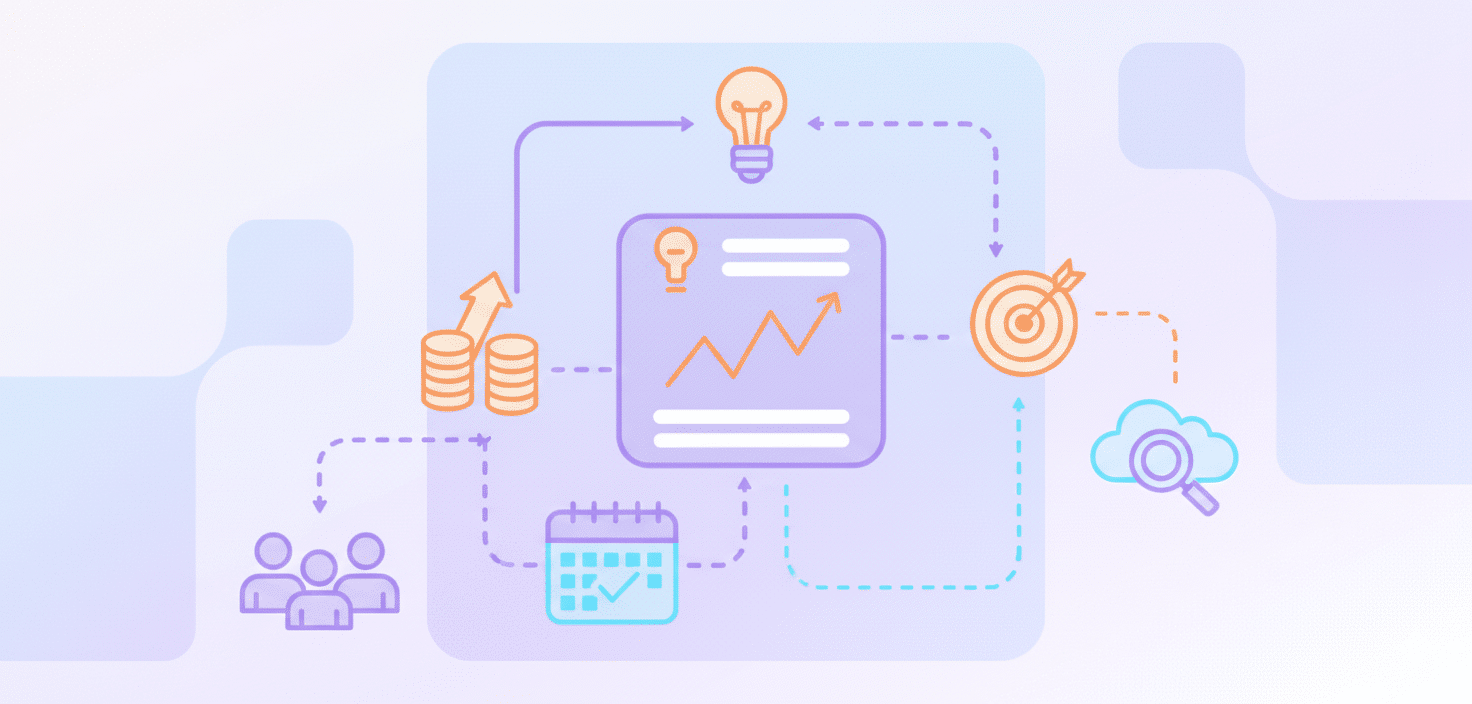SaaSの営業
SaaSの営業予測とは?

SaaSの営業予測とは?
SaaS売上予測とは、サービスとしてのソフトウェア(SaaS)ビジネスにおける将来の売上収益を予測することです。SaaS売上予測では、データ、業界トレンド、および重要な指標を分析して将来の収益を評価します。
分析される主要指標:
-
- 月間経常収益(MRR)
- 解約率
- 平均販売サイクル
SaaS売上予測結果の信頼性は、あなたのCRMシステムを通じて収集されたデータの正確性にかかっています。
私のビジネスにとって、SaaS売上予測はなぜそれほど重要なのでしょうか?
SaaS収益予測は、SaaSおよびソフトウェアビジネスの財務計画に関連しています。
- 正確な予測は以下の点に役立ちます:
- 価格戦略を策定する。
- 持続可能な規模拡大を実現する。
- 潜在的な流動性問題に備えて、先手を打って計画する。
- 最適なリソース配分を支援する。
- 安定した財務軌道は、ステークホルダーの信頼に影響を与える可能性があります。
- 不正確な予測のリスク:
- 成長の管理を誤る。
- 重要なリスクの特定不足。
- 拡大の機会(例:アップセル、新製品ティア)を逃すこと。
SaaS販売予測と収益予測の違いは何ですか?
SaaSの売上予測は取引量を見積もることに着目します。SaaSの収益予測は収益全体を考慮します。これら2つの概念を比較してみましょう。
|
機能 |
SaaS売上予測 |
SaaS収益予測 |
|
主な焦点 |
取引量(主に新規販売) |
総予測収益 |
|
利用目的 |
範囲が狭い |
範囲が広い;新規販売、 更新, アップグレード、サブスクリプション、およびトライアル |
|
ガバナンス |
非公式的 |
通常、会計原則(例: GAAP)に準拠するため |
一般的なSaaS売上予測モデルにはどのようなものがありますか?
SaaSの売上予測は、特定のモデルを通じていくつかの方法で実現できます。それぞれに独自の仕様があり、それに基づいてお客様のビジネス状況に合ったオプションを選択できます。
- 既存のSaaS予測モデル:
- 履歴データによる予測
- パイプラインステージ予測
- コホートベース予測
- AI駆動型モデル
- 選択基準(選び方):
- 企業規模
- 営業プロセスの複雑性
- データ品質
- ビジネスモデル
- すべてのSaaS売上予測モデルはデータに基づいて機能します。
- 財務計画に影響を与えるため、収益とキャッシュフローを区別することが重要です。
SaaS売上予測を効果的に行うにはどうすればよいですか?
以下は、SaaS売上予測のステップです。
過去のデータを分析する: 過去の実績を考慮し、CAC(顧客獲得コスト)、チャーンレート、売上数、LTV(顧客生涯価値)などの指標を確認します。- SaaS売上予測モデルを選択する: ビジネス要件に応じて、目標に合致するモデルを選択してください。
- 予測をグループ化する:収益タイプ別に売上予測をセグメント化して、より詳細に把握します。一般的なセグメントは次のとおりです。
- 新規事業
- 更新
- アップセル
- パターンを考慮する: 季節性などのトレンドを考慮に入れます。
- 評価と調整: 予測を定期的に監視およびレビューします。実績を予測と比較し、精度を高めるためにプロセスを調整します。
SaaS売上における妥当な予測期間はどのくらいですか?
適切な予測期間は、企業の段階と市場の安定性によって異なります。
- 予測期間に影響を与える要因:
-
- 企業の販売サイクル
- 成長段階
- 全体的な市場動向
企業の成長段階は、その予測期間を決定する主要因となります。
|
企業の種類 |
標準的な予測期間 |
根拠 |
|
スタートアップ |
短期(例:四半期ごと、半年ごと) |
急速な市場変化と進化するモデルに対応するため、俊敏性と迅速な調整を可能にします。 |
|
確立された企業 |
長期(例:年ごと、複数年) |
販売サイクルと市場での位置付けがより予測可能であるため、長期的な戦略的計画をサポートします。 |
予測期間は、Go-To-Market (GTM) 戦略、投資家の期待、短期的な適応性と長期的なビジョンの両方の必要性に合わせて調整する必要があります。
営業パイプラインはSaaS売上予測にどのように影響しますか?
セールスパイプラインは、潜在的な収益の構造化された概要を提供し、これは正確な予測にとって非常に重要です。
- パイプラインが示すもの:
-
-
- 現在の案件
- 各案件のステージ
- 成約の可能性
-
- パイプラインの可視性により、次のことが可能になります:
-
-
- 潜在的な収益ギャップを特定する。
- 営業戦略を最適化する。
- データに基づいた意思決定を行う。
-
- テクノロジーの役割:
ビッグデータと機械学習の発展は、CRMツール(例: Salesforce)に頻繁に統合されており、パイプライン管理と予測の信頼性に影響を与える可能性があります。
顧客獲得コスト (CAC) とユーザーあたりの平均収益 (ARPU) は、SaaSの売上予測にどのように影響しますか?
CACとARPUは、SaaS売上予測の正確さと現実性に大きく影響する重要な指標です。
- ARPU(ユーザーあたりの平均収益): この指標は収益の期待に直接影響します。ARPUが高いほど、一般的に収益予測は増加します。
- CAC (顧客獲得コスト)この指標は、最終損益と収益性に影響を与えます。CACが低いほど、予測における収益性が向上します。
時間の経過とともにCACとARPUの関係を監視し、これらの傾向に基づいて予測を調整することは、現実的な見通しを維持するために不可欠です。
内部的な変化はSaaSの売上予測にどのように影響しますか?
内部的な変化は、予測の基盤となった前提を変化させることで、販売予測に大きな影響を与えます。
- 予測に影響を与える一般的な内部的変化:
-
-
- 新規採用(特に営業部門)
- 製品の発売
- 価格調整
- 新しいマーケティングの取り組み
-
- なぜ予測の更新が重要なのか:
-
-
- これらの要因は、予測売上を増加させることも減少させることもあります。
- 正確で最新の予測は、効果的な財務計画とリソース配分に不可欠です。
-
- 影響の例:
-
-
- リードジェネレーション 新しいマーケティングキャンペーンによって影響を受ける可能性があります。
- 価格の上昇は販売量を減少させる可能性がありますが、顧客あたりの収益を増加させる可能性があります。
-
- 変更を統合する方法:
過去のデータとこれまでの 市場トレンド (例:季節性、過去のプロモーションの影響)などを考慮し、潜在的な影響をモデル化して予測精度を向上させるため。
結論
SaaSの売上予測は、将来の収益を評価し、詳細な計画と意思決定を可能にする重要なツールです。適切な予測モデルを選択し、変更を加えることが結果に影響を与える可能性があります。そのため、これらの点を念頭に置くことはSaaS企業にとって重要です。